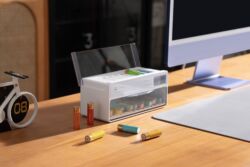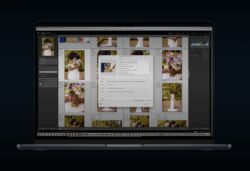There are so many different ways to edit skin in Photoshop. Some techniques produce lovely, natural results and others, a gag worthy, plastic mess. Frequency separation is by far my favorite method to correct skin, but it is also very time consuming. As a result, we need to have a few methods for retouching skin that are a little quicker.
A Hue and Saturation layer is an excellent way to quickly adjust the color of skin. It’s not as versatile as Frequency Separation but it’s much quicker and far easier to get your head around. I use it all the time for making subtle adjustments to a person’s face and even use this method to make more global refinements.

This photo is already pretty good. However, as you can see below, there are a couple areas that I would like to adjust. There’s some patchy redness between the eyebrows as well as on the left cheek. And there’s also a bit of discoloration under the eyes. My personal preference when it comes to editing is not to make things 100% perfect; although it does depend on what I’m editing. In general, with portraits, I like to enhance rather than perfect. There’s been a bit of a shift in recent years, away from overly Photoshopped images and toward something a little more natural. That’s where I like to reside.

Retouching In Photoshop: How To Use Hue & Saturation to Correct Skin
Having identified our problem areas, we can use Hue and Saturation to isolate the colors and adjust them accordingly. Our 1st step is to create a new Hue and Saturation layer. With that done, we need to select the correct colour channel.
[REWIND: A TOUCH OF WONDERLAND | PHOTOSHOP BREAKDOWN & TIPS FOR PHOTO MANIPULATION]
We could guess the color channel we want and just select it from the drop-down menu at the top (where it says “master”), or we could use the “Targeted Adjustment Tool,” aka the hand with the arrows (see photo below). With that tool selected, click on the area you would like to adjust. In this case, I chose the area beneath my subject’s left eye. Photoshop automatically selected the red channel.

We could stop here and begin adjusting, but if we did, we would be making fairly broad adjustments to the red channel, and that’s not what we want to do. To further refine the selection, we’re going to use the Color Range slider at the bottom of this panel; it’s circled in the photo above. The Color Range slider will allow us to target a far more precise range of colors, thus enabling us to make defined adjustments to skin imperfections.
Within the Color Range Slider, there are three adjustments we can make. The first two control how wide our selection is (how many colors/shades we are affecting) and the speed at which that selection falls off. The other moves that selection throughout the entire colour range of our image.
If you look at the slider, you will see two white lines and two circles either side. The closer the lines are together, the fewer colors/shades you will be affecting. The circles represent the fall off of that selection. It’s sort of like feathering. If those circles are very close to the lines, then your selection will abruptly stop. Whereas, move the circles further away and it gradually fades away.
QUICK TIP – When making your selection, drag the saturation slider up to 100. By doing so, it makes it very easy to see what part of your image you are affecting, see below.

Retouching In Photoshop: Adjusting The Color
We’ve now selected a very narrow range of colours that we can adjust. All you have to do is move the hue slider until you start to see the desired result. Once you do, add a mask to your layer and fill this mask with black. Remember, we want this to be very targeted, and hence we don’t want our adjustment affecting any other part of our image. Use a white brush on the layer mask and paint the adjustment where needed. As this is such a targeted technique, I often use a few of these layers to adjust different parts of the face.
Here is the final photo with the skin having been corrected. If I were making this “perfect,” there are still many things I would adjust. For the purpose of this image, however, it is “perfect.”

You could use this technique to take away blotchy redness, that magenta tint people often get around their eyes, or even alter the color in a more global way. For example, if you wanted to take away a large amount of redness from a person’s face, I strongly advise caution. When making larger adjustments, even minor changes to Hue can have a very big impact.
[REWIND: DOWN & DIRTY DODGE AND BURN TECHNIQUE USING ‘BLEND IF’]
These next two photos are a good example of a more global approach to this technique. I wanted to reduce the red hue from around the cheeks, nose and mouth. Given that this was all within the same color range I was able to do so with one adjustment layer. However, as it was a global adjustment, I was more cautious with settings.
BEFORE:

AFTER:

Retouching In Photoshop: Hue & Saturation Summary
There are so many different ways to edit skin in Photoshop. Some take hours and some take minutes, but very few are wrong; if used correctly. As I often say about gear, it’s the right tool for the right job. Spending 2 hours editing each photo from a family photo shoot is just daft, whereas, that may be more common in high fashion. For beauty, you might be spending far longer to achieve that “perfect” look.
The key to Lightroom and Photoshop, in fact, just editing, in general, is to absorb as much info as you can. Equip yourself with an array of techniques that can be utilized at the right moment. It’s usually either time or budget constraints which will determine what is best for you to use.
For some fantastic time-saving presets for Lightroom, be sure to check out the SLR Lounge Preset System. The system that the team have created is an excellent time-saving tool which I’m able to use on 90% of jobs. You can find it here.













